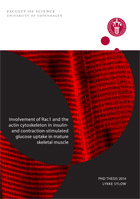PhD defence: Involvement of Rac1 and the actin cytoskeleton
in insulin- and contraction-stimulated intracellular signaling and glucose uptake in mature skeletal muscle
Lykke Sylow Hansen
PhD thesis
Type 2 Diabetes affects ~10 % of western adults and is associated with poor organ sensitivity to insulin that is secreted following a meal. Insulin resistance, particularly in the liver, fat, and skeletal muscle, is a key event in the pathogenesis of Type 2 Diabetes and contributes to hyperinsulinemia and hyperglycemia. Blood glucose is taken up into skeletal muscle when glucose transporters move to the muscle cell surface. In muscle cells this process depends on the protein Rac1.
Glucose uptake into skeletal muscle can also occur via insulin-independent mechanisms, such as during muscle contractions. Contraction-stimulated glucose uptake is not affected by insulin resistance, likely because the intracellular events that regulate GLUT4 translocation by insulin and muscle contraction are distinct. In addition, muscle contraction has insulin sensitizing effects. Activation of glucose uptake by exercise is therefore an important alternative way to maintain whole body glucose homeostasis in insulin resistant states such as Type 2 Diabetes.
Although the insulin- and exercise-stimulated signaling pathways to glucose uptake have been studied extensively, the underlying mechanisms are not well understood. The aim of the current PhD was therefore to investigate the involvement of Rac1 and the actin cytoskeleton in the regulation of insulin- and contraction-stimulated glucose uptake in mature skeletal muscle.
The central findings of this PhD thesis was that Rac1 was activated by both insulin and muscle contraction in mouse and human skeletal muscle. Most importantly, Rac1 was involved in the regulation of both insulin- and contraction-stimulated glucose uptake. Interestingly, Rac1 signaling was defective in skeletal muscle of insulin resistant obese and T2D human subjects as well as in obese mice.
This leads to the conclusion that Rac1 is a regulator of insulin- and contraction-stimulated glucose uptake in skeletal muscle. Furthermore, this PhD thesis identifies a novel mechanism by which skeletal muscle insulin resistance may develop.
2014, 144 pages,
ISBN 978 87 7611 718 4
Time
27 March 2014 at 14:30
Venue
Auditorium 1, August Krogh building, Universitetsparken 13, Copenhagen.
Opponents
Professor Ylva Hellsten (chair), Department of Nutrition, Exercise and Sports, University of Copenhagen, Denmark.
Dr. Anna Krook, Department of Physiology and Pharmacology, Karolinska Institute, Sweden.
Dr. Kei Sakamoto, Nestlé Institute of Health Sciences SA, Switzerland.
Supervisor
Professor Erik A. Richter, Department of Nutrition, Exercise and Sports, University of Copenhagen, Denmark.

